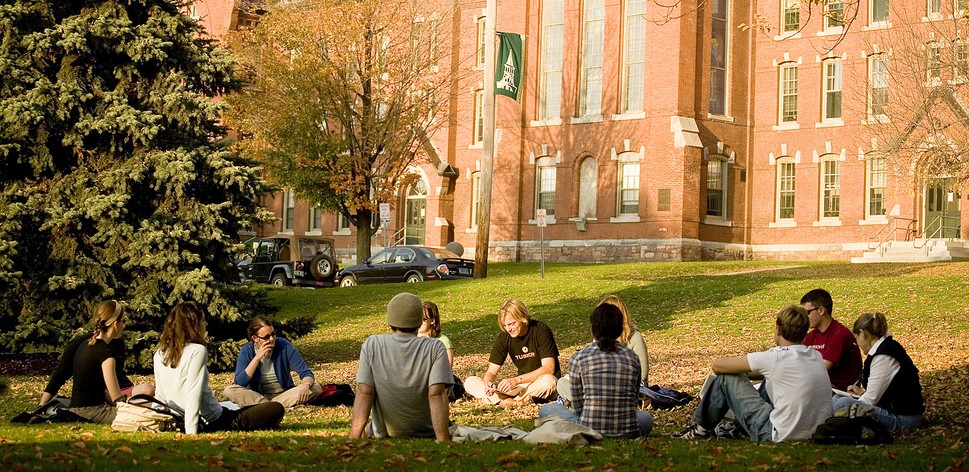By Cynthia Belliveau, EdD
Dean, UVM Continuing and Distance Education
Skyrocketing tuition costs. Falling graduation rates. Lagging performance indicators. The identity crisis and uncertain future of higher education in the United States isn’t going away. The Economist dedicated its entire March issue to the state of higher education, and its report was far from rosy.
Here are some highlights on the future of higher education from The Economist:
- After years of big increases in tuition fees, universities are facing resistance from the customers, and financial prospects for the sector are looking gloomy. Moody’s has a negative outlook as well: Universities are “expecting the weakest net tuition revenue in a decade in fiscal year 2015.” It expects tuition fees at public universities to rise by an average of only 1.9%, though at private universities the increase is likely to be a more comfortable 2.7%. In the past five years, college enrollment among those finishing high school has fallen, as cash-strapped community colleges turn applicants away and for-profits restrict recruitment of marginal students.
- In 2014, 19 of the 20 universities in the world that produced the most highly cited research papers were American. But on the educational side, American graduates score poorly in international numeracy and literacy rankings and are continuing to slip. In a recent study of academic achievement, 45% of American students made no gains in their first two years of college. Meanwhile, tuition fees have nearly doubled in 20 years. Student debt, at nearly $1.2 trillion, has surpassed credit-card and car-loan debt.
- A bachelor’s degree in America still yields, on average, a 15% return. But it is less clear whether the growing investment in tertiary education makes sense for society as a whole. If graduates earn more than non-graduates because their studies have made them more productive, then university education will boost economic growth, and society should want more of it. Yet low student scores suggest otherwise. So, too, does the testimony of employers. A recent study of recruitment by professional-services firms found that they took graduates from the most prestigious universities not because of what the candidates might have learned, but because of those institutions’ tough selection procedures. In short, students could be paying vast sums merely to go through an elaborate sorting mechanism.
What does the future of higher education look like—or by way of this simplistic question raised by the critics—how can universities reinvent themselves? My own question is this: What would happen if the university stopped using its own language to explain what it does and started using words that others outside of academia could understand? Imagine the effects of replacing traditional language, like “general education requirements, numeracy, and critical thinking,” with more exacting language, like “will learn to think and reason and calculate in order not to be susceptible to scams perpetrated by Wall Street, Madison Avenue, or Jim Jones.” Or, “will learn to write, speak, and argue in order to become a thoughtful, non-partisan, solution maker and end the insanity in DC.” Or “will learn through the exploration of theories and hands-on problem solving with some of the best thinkers in the world to save you and future generations from starvation, environmental degradation, and inequity.”
I argue that colleges and universities don’t need to ”reinvent themselves” because what they teach is holistically and eternally important. Perhaps the university needs to use the language of its critics proactively and continue to protect its sacred place, where fostering new knowledge is—and should continue to be—the ultimate goal. Reinvention is not the exercise here. Instead, let’s hire skilled, fierce interpreters, who have been “out there” and who can broadcast skillfully what’s actually happening within the university system so that the issues are understandable to those throwing stones. In other words, let’s take the offensive and determine our proper course. And let’s leave the scholars to study and teach.
I say this knowing that there are very few skilled polyglots inside the university, at least that we know of, mainly because faculty members don’t trust anyone to represent them or interpret their policies who hasn’t come up through their ranks, “speaking their language.” But not being understood exacerbates scholastic xenophobia, which then increases defensiveness and further fuels criticism. This is what we’re seeing in the above excerpts from The Economist.
In order to quell the doomsayers, universities cannot rest on their laurels. There is much work to be done. We can’t continue to believe that the on-site classroom is the only place to learn. We have to embrace new technologies and give access to students outside the 18-to-21 demographic. We must accept that there are new patterns of matriculation, duration, and credentialing. We’ve got to get serious about what has to go and what gets to stay regarding programs and faculty. And we have to stop blaming “administration” for all our troubles; “they” are us. Turning tail and panicking with across-the-board, chronic cost cutting with no strategies, because it’s “too hard to get consensus,” is killing us. Turning over leadership every couple of years, when we don’t like what we hear, escalates costs we can’t afford. Reconfiguring incestuous power structures holds us back. Fearfully editing missives to say nothing, and harboring distaste for stakeholders who disagree, reinforces the perception of our cowardice.
Using our own critical thinking skills to solve our problems is key to our future success, but only if we allow others in to help. We need to take ownership of what changes need to happen, hire good interpreters, and really listen to them, or carefully learn the language ourselves. Either way, it’s time we step up.
 Cynthia Belliveau, EdD, is the Dean of UVM Continuing and Distance Education.
Cynthia Belliveau, EdD, is the Dean of UVM Continuing and Distance Education.





